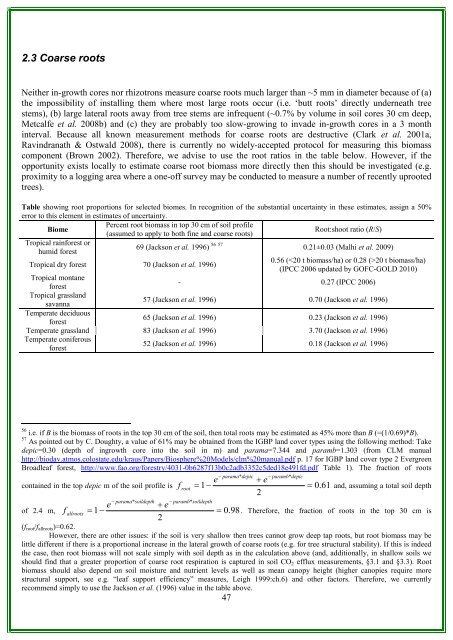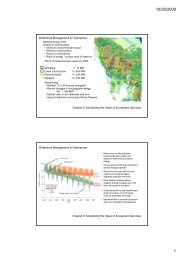RAINFOR GEM Intensive Plots Manual (pdf) - University of Oxford
RAINFOR GEM Intensive Plots Manual (pdf) - University of Oxford
RAINFOR GEM Intensive Plots Manual (pdf) - University of Oxford
- No tags were found...
You also want an ePaper? Increase the reach of your titles
YUMPU automatically turns print PDFs into web optimized ePapers that Google loves.
2.3 Coarse rootsNeither in-growth cores nor rhizotrons measure coarse roots much larger than ~5 mm in diameter because <strong>of</strong> (a)the impossibility <strong>of</strong> installing them where most large roots occur (i.e. ‘butt roots’ directly underneath treestems), (b) large lateral roots away from tree stems are infrequent (~0.7% by volume in soil cores 30 cm deep,Metcalfe et al. 2008b) and (c) they are probably too slow-growing to invade in-growth cores in a 3 monthinterval. Because all known measurement methods for coarse roots are destructive (Clark et al. 2001a,Ravindranath & Ostwald 2008), there is currently no widely-accepted protocol for measuring this biomasscomponent (Brown 2002). Therefore, we advise to use the root ratios in the table below. However, if theopportunity exists locally to estimate coarse root biomass more directly then this should be investigated (e.g.proximity to a logging area where a one-<strong>of</strong>f survey may be conducted to measure a number <strong>of</strong> recently uprootedtrees).Table showing root proportions for selected biomes. In recognition <strong>of</strong> the substantial uncertainty in these estimates, assign a 50%error to this element in estimates <strong>of</strong> uncertainty.Percent root biomass in top 30 cm <strong>of</strong> soil pr<strong>of</strong>ileBiomeRoot:shoot ratio (R/S)(assumed to apply to both fine and coarse roots)Tropical rainforest orhumid forestTropical dry forest 70 (Jackson et al. 1996)69 (Jackson et al. 1996) 56 57 0.21±0.03 (Malhi et al. 2009)0.56 (20 t biomass/ha)(IPCC 2006 updated by GOFC-GOLD 2010)Tropical montaneforest- 0.27 (IPCC 2006)Tropical grasslandsavanna57 (Jackson et al. 1996) 0.70 (Jackson et al. 1996)Temperate deciduousforest65 (Jackson et al. 1996) 0.23 (Jackson et al. 1996)Temperate grassland 83 (Jackson et al. 1996) 3.70 (Jackson et al. 1996)Temperate coniferousforest52 (Jackson et al. 1996) 0.18 (Jackson et al. 1996)56 i.e. if B is the biomass <strong>of</strong> roots in the top 30 cm <strong>of</strong> the soil, then total roots may be estimated as 45% more than B (=(1/0.69)*B).57 As pointed out by C. Doughty, a value <strong>of</strong> 61% may be obtained from the IGBP land cover types using the following method: Takedepic=0.30 (depth <strong>of</strong> ingrowth core into the soil in m) and parama=7.344 and paramb=1.303 (from CLM manualhttp://biodav.atmos.colostate.edu/kraus/Papers/Biosphere%20Models/clm%20manual.<strong>pdf</strong> p. 17 for IGBP land cover type 2 EvergreenBroadleaf forest, http://www.fao.org/forestry/4031-0b6287f13b0c2adb3352c5ded18e491fd.<strong>pdf</strong> Table 1). The fraction <strong>of</strong> roots− parama*depiccontained in the top depic m <strong>of</strong> the soil pr<strong>of</strong>ile is f = 1−= 0. 61 and, assuming a total soil depth− parama*soildepth+ e2root− paramb*soildepthe47+ e2− paramb*depic<strong>of</strong> 2.4 m, f = 1−= 0. 98 . Therefore, the fraction <strong>of</strong> roots in the top 30 cm isallrootse(f root /f allroots )=0.62.However, there are other issues: if the soil is very shallow then trees cannot grow deep tap roots, but root biomass may belittle different if there is a proportional increase in the lateral growth <strong>of</strong> coarse roots (e.g. for tree structural stability). If this is indeedthe case, then root biomass will not scale simply with soil depth as in the calculation above (and, additionally, in shallow soils weshould find that a greater proportion <strong>of</strong> coarse root respiration is captured in soil CO 2 efflux measurements, §3.1 and §3.3). Rootbiomass should also depend on soil moisture and nutrient levels as well as mean canopy height (higher canopies require morestructural support, see e.g. “leaf support efficiency” measures, Leigh 1999:ch.6) and other factors. Therefore, we currentlyrecommend simply to use the Jackson et al. (1996) value in the table above.





